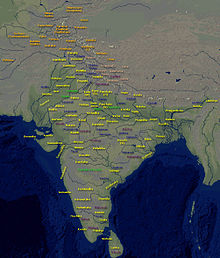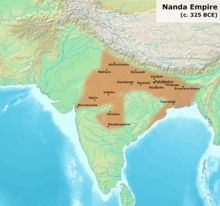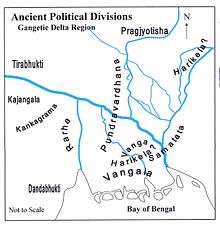This is an old revision of this page, as edited by GtAM6 (talk | contribs) at 12:00, 12 January 2025 (-- Draft creation using the WP:Article wizard -- First Additions (Article - Incomplete)). The present address (URL) is a permanent link to this revision, which may differ significantly from the current revision.
Revision as of 12:00, 12 January 2025 by GtAM6 (talk | contribs) (-- Draft creation using the WP:Article wizard -- First Additions (Article - Incomplete))(diff) ← Previous revision | Latest revision (diff) | Newer revision → (diff) | This article, Ancient history of Bangladesh, has recently been created via the Articles for creation process. Please check to see if the reviewer has accidentally left this template after accepting the draft and take appropriate action as necessary.
Reviewer tools: Inform author |
 | This article, Ancient history of Bangladesh, has recently been created via the Articles for creation process. Please check to see if the reviewer has accidentally left this template after accepting the draft and take appropriate action as necessary.
Reviewer tools: Inform author |
| Ancient history of Bangladesh | |
|---|---|
 Ptolemy map illustrating the Ganges and beyond Ptolemy map illustrating the Ganges and beyond | |
| History | |
| • Dawn of the Bronze Age in South Asia and beginning of the Ancient Era of Bangladesh - c. 3000 BCE | 3000 BCE |
| • Pundra Kingdom | c.1280 BCE |
| • Janapada and Vedic Period | c.1100 BCE |
| • Prince Vijaya's conquest of the island of Lanka and the establishment of the House of Vijaya in Sri Lanka | 543 BCE |
The ancient history of Bangladesh is a period of time, part of a series on the History of Bangladesh, dating back over multiple millennia. The region's ancient history is comprised of a sequence of different independent regional kingdoms and the various Magadha dynasties. Due to Bangladesh's geography and the plethora of rivers, namely the Ganges, Meghna and Padma rivers, and their constant shifting, archeological evidence regarding the ancient history of Bangladesh has been scarce. Due to this, many historians have been more partial to prioritising other, well documented or recent areas of the history of Bangladesh.
Overview
The Oxford History of India categorically claims that there is no definitive information about Bengal before the third century BCE. It is believed that there were movements of Austro-asiatics, Tibeto-Burmans, Indo-Aryans, Dravidians and Mongoloids, including a people called Vanga, into Bengal. One view argues that humans entered Bengal from China 60,000 years ago. Another view claims that a distinct regional culture emerged 100,000 years ago.

Due to Bangladesh's natural geography there are plentiful rivers and many tributaries of those rivers. Naturally, overtime these rivers shifted their courses', causing the natural landscape of the region to be unsuitable for tangible archaeological evidence and remains. Hence the very weak evidence for a prehistoric human presence in the region. The lack of stones suggests that the early humans in Bengal probably used materials such as wood and bamboo that could not survive in the environment. Human presence during the Neolithic and Chalcolithic eras also seem to be similar with scant evidence. This usually means that archaeological discoveries are almost entirely from the hills around the Bengal delta. Industries of fossil-wood manufacturing blades, scrapers and axes have been discovered in Lalmai, Sitakund and Chaklapunji. These have been connected with similar findings in Myanmar and West Bengal. Large stones, thought to be prehistoric, were constructed in north eastern Bangladesh and are similar to those in India's nearby hills. West Bengal holds the earliest evidence of settled agrarian societies.

Moreover, during the fifth century BCE there was widespread agricultural success for stationery cultures with the emergence of cross-sea trade, some of the earliest polities and many towns. Wari-Bateshwar, was an ancient city within the region and traded with Ancient Rome and Southeast Asia. Archaeologists have discovered coinage, pottery, iron artefacts, bricked road and a fort in Wari-Bateshwar. The findings connote that this city was an administrative hub with industries such as iron smelting and valuable stone beads. The site shows extensive use of clay and bricks, which were most prominent on the walls. Chandraketurgarh in West Bengal is home to some of the most famous terracotta plaques, made by clay depicting deities and scenes of ordinary life and nature. The early coinage unearthed in Wari-Bateshwar and Chandraketugarh were found to be illustrating boats.
The Northern Black Polished Ware (NBPW or NBP) was a culture of the Indian Subcontinent lasting between c. 700–200 BCE. It peaked from c. 500 - 300 BCE and coincided with the emergence of the 16 Mahajanapadas of North India and the eventual rise of the Magadhan Dynasties.
Militarily, ancient Bangladesh possessed mighty armies consisting of eighty thousand horsemen, two hundred thousand footmen, eight thousand chariots, and six thousand war elephants. The combined might of the Nanda's and the Gangaridai would then go on to cause Alexander the Great's withdrawal from India. Fearing the prospect of facing other large armies and exhausted by years of campaigning, Alexander's army mutinied at the Hyphasis River (Beas), refusing to march farther east. This river thus marks the easternmost extent of Alexander's conquests.
Vedic Period and the Janapadas

The Janapadas were the realms, republics and kingdoms of the Indian subcontinent during the Vedic period. They surfaced all across the Indian subcontinent and lasted between c. 1100–600 BCE. The Vedic period reached from the late Bronze Age into the Iron Age - from about 1500 BCE to the 6th century BCE. With the rise of sixteen Mahajanapadas ('great janapadas'), most of the states were annexed by more powerful neighbours, although some remained independent. Among some of these independent entities were the Pundra and Vanga Kingdom which were the most eminent kingdoms from the region.
Pundra Kingdom
See also: PundravardhanaThe Pundra Kingdom or Pundravardhana emerged during the late Bronze Age around c. 1280 BCE and was the very first documented independent kingdom in the region of Bangladesh. It was mostly known for being the home and birthplace of Ācārya Bhadrabahu. Bhadrabahu was the spiritual teacher of Chandragupta Maurya, the founder of the Maurya Empire.
24°58′N 89°21′E / 24.96°N 89.35°E / 24.96; 89.35Mahasthangarh, the ancient capital of Pundravardhana is located 11km (7mi) north of Bogra on the Bogra-Rangpur highway, with a feeder road (running along the eastern side of the ramparts of the citadel for 1.5km) leading to Jahajghata and site museum.
Vanga Kingdom

The Vanga Kingdom was a powerful seafaring nation of Ancient Bengal. They had overseas trade relations with Java, Sumatra and Siam (modern day Thailand). According to Mahavamsa, the Vanga prince Vijaya Singha conquered Lanka (modern day Sri Lanka) in 544 BC and gave the name "Sinhala" to the country. Bengali people migrated to the Maritime Southeast Asia and Siam (in modern Thailand), establishing their own settlement there.
Kurukshetra War
The Kurukshetra War, c. 400 BCE - c. 500 BCE, is a war described in the Hindu epic poem Mahabharata, rising from a struggle between two groups of cousins, the Kauravas and the Pandavas to acquire the throne of Hastinapura. The Vanga Kingdom sided with the Kauravas. However the historical accuracy of the Kurukshetra War and the Mahabharata is uncertain and unclear.
Vangas sided with Duryodhana in the Kurukshetra War (8:17) along with the Kalingas. They are mentioned as part of the Kaurava army at (7:158). Many foremost of combatants skilled in elephant-fight, belonging to the Easterners, the Southerners, the Angas, the Vangas, the Pundras, the Magadhas, the Tamraliptakas, the Mekalas, the Koshalas, the Madras, the Dasharnas, the Nishadas united with the Kalingas (8:22). Satyaki, pierced the vitals of the elephant belonging to the king of the Vangas (8:22). Behind Duryodhana proceeded the ruler of the Vangas, with ten thousand elephants, huge as hills, and each with juice trickling down (6:92). The ruler of the Vangas (Bhagadatta) mounting upon an elephant huge as a hill, drove towards the Rakshasa, Ghatotkacha. On the field of battle, with the mighty elephant of great speed, Bhagadatta placed himself in the very front of Duryodhana's car. With that elephant he completely shrouded the car of thy son. Beholding then the way (to Duryodhana's car) thus covered by the intelligent king of the Vangas, the eyes of Ghatotkacha became red in anger. He ruled that huge dart, before upraised, at that elephant. Struck with that dart hurled from the arms of Ghatotkacha, that elephant, covered with blood and in great agony, fell down and died. The mighty king of the Vangas, however, quickly jumping down from that elephant, alighted on the ground (6:93).

Prince Vijaya
See also: Prince Vijaya and House of VijayaPrince Vijaya was born in the Vanga Kingdom and is one of the most notable figures of the Vanga Kingdom. He is also known in Sri Lankan History for being the first King of Sri Lanka. Prince Vijaya was made prince regent by his father, but the young prince and his band of followers would go on to become notorious for their violent deeds. With multiple complaints from Vijaya's father failing, many citizens opted for Vijaya's death. King Sinhabahu then expelled Vijaya and 700 of his followers from the kingdom. The prince left the Kingdom of Vanga and would eventually reach the northern tip of the island of Sri Lanka where he would establish the Kingdom of Tambapanni. The descendants of Prince Vijaya (from the House of Vijaya) would rule the island for next 500 years and also go on to establish the Kingdom of Upatissa Nuwara and finally the Anuradhapura Kingdom.
Prince Vijaya's party of several hundred landed in Sri Lanka, were split on the journey. The men, women and children were on separate ships. Vijaya and his followers landed at a place called Supparaka; the women landed at a place called Mahiladipaka present day (Maldives), and the children landed at a place called Naggadipa. Vijaya eventually made it to the island of Lanka.
Oversea Settlements of Vanga
The Vanga Kingdom was known for its superior naval fleets and naval supremacy. According to the Mahabarata (major Indian epic) the Vanga Kingdom also colonised territory outside of mainland India. While this claim is not very likely it cannot be ignored completely because of the instances the Vanga Kingdom having oversea settlements and the special case of Prince Vijaya's conquest of the island of Lanka.
This can be observed with the supposed Vanga settlements in the island of Mahiladipaka in the Maldives and Prince Vijaya's conquests of Lanka when the women of Prince Vijaya's party went astray and landed at Mahiladipaka. There has also been findings of Vanga settlements in Southeast Asia. Most notably in Champa (present-day Vietnam), where a settlement was founded in Cochinchina. The settlement was named after a native Bengali name
Gangaridai and the Nanda Dynasty
Independent Gangaridai
Not much is known about the independent state of Gangaridai and when it was independent, however renowned Bengali historian, Rakhaldas Bandyopadhyay, noted that during the rule of Chandragupta Maurya, the state of Gangaridai was independent. The state of Gangaridai was established c. 300 BCE.
Establishment of the Nanda Dynasty

R.C Majumdar and D.C Sircar both argue that the Nanda dynasty was of Gangaridae (Bengali) origin. The Nanda's, are represented as the lord of both "Prasioi and the Gangaridai" or of Gangaridai alone. The description of Prasioi was a general name for the people of Eastern India, so the specific mention of Gangaridai attaches significance. The importance of Gangaridai or the Vanga people (Lower Bengal) may be explained by the suggestion of the Nanda dynasty belonging to them.
The idea of the Bengali origin of the Nanda's can also be observed through Greek accounts of Xandrames (Greek for 'Nanda'). As Diodorus explicitly states, Plutarch affirms and Arrian evidently implies, Bengal had conquered Magadha. This view is also compatible with the Puranic account and would explain the low position of these kings in the Puranas as Bengal was outside the domain of Aryan Culture during this time.
Alexanders the Great's withdrawal
Main article: Alexander the Great
East of Porus's kingdom, near the Ganges River, was the Nanda Empire of Magadha and the Gangaridai Empire of the Bengal region in the Indian subcontinent. Fearing the prospect of facing other large armies and exhausted by years of campaigning, Alexander's army mutinied at the Hyphasis River (Beas), refusing to march farther east.
Alexander tried to persuade his soldiers to march farther, but his general Coenus pleaded with him to change his opinion and return. Alexander eventually agreed and turned south, marching along the Indus. Along the way his army conquered the Malhi (in modern-day Multan) and other Indian tribes; while besieging the Mallian citadel, Alexander suffered a near-fatal injury when an arrow penetrated his armor and entered his lung.
"As for the Macedonians, however, their struggle with Porus blunted their courage and stayed their further advance into India. For having had all they could do to repulse an enemy who mustered only twenty thousand infantry and two thousand horse, they violently opposed Alexander when he insisted on crossing the river Ganges also, the width of which, as they learned, was thirty-two furlongs , its depth one hundred fathoms , while its banks on the further side were covered with multitudes of men-at-arms and horsemen and elephants. For they were told that the kings of the Ganderites and Praesii were awaiting them with eighty thousand horsemen, two hundred thousand footmen, eight thousand chariots, and six thousand war elephants."
Samatata
Magadha Dynasties
Well developed towns had emerged by 300 BCE such as Tamralipti (present-day Tamluk, West Bengal, India), Mahasthan and Mainamati. Instead of the seaside, main towns sprang up by the riversides. Mahasthan contains the earliest piece of writing in Bangladesh, a stone inscription. It indicates that the site was an important town in the Maurya empire. Mahasthan is believed to have then been a provincial centre.> The inscription, in Prakrit, apparently contains a command to stock up supplies in case of an emergency. The inscription is called the Mahasthan Brahmi Inscription. Bengal was the eastern frontier of the Mauryan empire. Western Bengal with its port of Tamralipti achieved importance under the Mauryas.
A prominent view in scholarship is that the Mauryan and Gupta empires exercised authority over most parts of the Bengal delta. The incomplete evidence which exists suggests that Bengal's western rather than eastern regions were parts of larger empires. The ancient zones in Bengal were the Bhagirathi-Hooghly basin, Harikela, Samatata, Vanga and Varendra. Vanga is believed to be central Bengal, Harikela and Samitata were apparently Bengal's eastern zones and Varendra was northern Bengal. The names of sites indicate that Tibeto-Burman, Austro-Asiatic and Dravidian languages were spoken by the majority of people. Indo-European languages became prominent from 400 BCE.
Trade
Indo-Roman trade Relations
Southwestern Silk Road
Muslin
Ancient Regions and divisions of Bangladesh

| Ancient region | Modern region |
|---|---|
| Pundravardhana | Rajshahi Division and Rangpur Division in Bangladesh; Malda division of West Bengal in India |
| Vanga | Khulna Division and Barisal Division in Bangladesh; West of the Padma river. |
| Samatata | Dhaka Division, Barisal Division and Chittagong Division in Bangladesh |
| Harikela | Sylhet Division, Chittagong Division, Dhaka Division and Barisal Division in Bangladesh |
References
Citations
- ^ Baxter 1997, p. 12.
- Willem 2009, p. 11.
- Willem 2009, p. 13.
- Willem 2009, p. 15.
- ^ Willem 2009, p. 17.
- ^ Willem 2009, p. 19.
- ^ Kosmin 2014, p. 34.
- Tripathi 1999, pp. 129–30.
- Misra 1973, p. 18.
- Hossain 2006, p. 14-15.
- ^ The Modern Review, p. 111-112.
- Mittal 2006, p. 405.
- Ratnatunga.
- The Mahavamsa, p. 06.
- Gangaridai.
- Sri Venkatesvara University 1979, p. 33.
- ^ Sircar 1984, p. 5.
- Majumdar 1925, p. 11.
- Tripathi 1999, pp. 137–38.
- Dodge, Theodore Ayrault (1890). Alexander. Great captains. Vol. 2. Houghton Mifflin. pp. 604–605.
- Plutarch 1919.
- ^ Willem 2009, p. 16.
- ^ Baxter 1997, p. 13.
- Willem 2009, p. 16-17.
- Willem 2009, p. 21.
- Richard 1996, p. 3.
Bibliography
- Baxter, Craig (1997). Bangladesh: From A Nation to a State. Westview Press. ISBN 978-0-813-33632-9.
- Willem, Schendel (2009). A History of Bangladesh. Cambridge University Press. ISBN 9780511997419.
- Richard, M. Eaton (31 July 1996). The Rise of Islam and the Bengal Frontier, 1204-1760. University of California Press. ISBN 978-0-520-20507-9. Archived from the original on 6 January 2017. Retrieved 9 January 2025.
- The Mahavamsa. "The Coming of Vijaya - the Sinhalese epic". Archived from the original on 30 October 2015. Retrieved 9 January 2025.
- Misra, Sudama (1973). Janapada state in ancient India. Vārāṇasī: Bhāratīya Vidyā Prakāśana.
- Hossain, Md. Mosharraf (2006). Mahasthan: Anecdote to History. Dibyaprakash. ISBN 984-483-245-4.
- Mittal, J.P (2006). History of Ancient India (A New Version) Volume 2. Atlantic. ISBN 9788126906161.
- The Modern Review. Ramananda Chatterjee (ed.). "The Modern Review Volume 12".
{{cite news}}: CS1 maint: url-status (link)
- Ratnatunga, Rhajiv. "Chapter I The Beginnings; And The Conversion To Buddhism". lakdiva.org.
- M. Senaveratna, John (2000). Royalty in Ancient Ceylon: During the Period of the "great Dynasty". Colombo, Sri Lanka: Asian Educational Services. ISBN 81-206-1530-1. Retrieved 9 January 2025.
- Gangaridai. "The Historic State of Gangaridai". Bangladesh.com. Archived from the original on 24 December 2024.
- Sri Venkatesvara University, Oriental Research Institute (1979). Sri Venkateswara University Oriental Journal Volumes 21–22.
- Sircar, D.C. (1984). Journal of Ancient Indian History, Vol-14.
- Majumdar, R.C (1925). The early history of Bengal (PDF). Oxford University Press.
- Plutarch (1919). Perrin, Bernadotte (ed.). Plutarch, Alexander. Perseus Project. Archived from the original on 21 October 2011. Retrieved 6 December 2011.
- Kosmin, Paul J. (2014). The Land of the Elephant Kings: Space, Territory, and Ideology in Seleucid Empire. Harvard University Press. ISBN 978-0-674-72882-0. Retrieved 9 January 2025.
- Tripathi, Rama Shankar (1999). History of Ancient India. Motilal Banarsidass Publ. ISBN 978-81-208-0018-2. Retrieved 9 January 2025.
